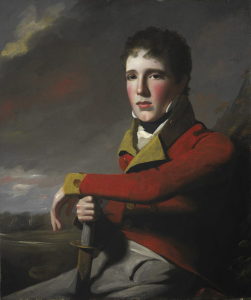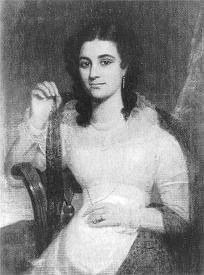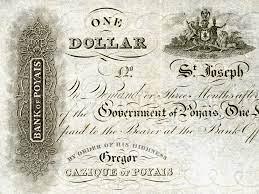‘Con-men', or confidence tricksters, have existed throughout history. Preying on desperate people, ambitious people, or just plain naïve people, they dazzle their subjects with grand ideas and charm, but above all a supreme confidence. In the modern era, the most famous conmen have included Frank Abignale Jr, memorably played by Leonardo DiCaprio in Catch me if you Can, and Charles Ponzi, who convinced investors to grant him money for non-existent investments. But beyond modern history, perhaps the most notorious conman was a Scot named Gregor MacGregor. Or should I say the Prince of Poyais. No, wait – the ‘Cazique'. These were just two of the monikers MacGregor used to seduce his subjects and convince them to invest their trust and money in him. Whether he was wittingly cruel or just completely indifferent to the fate of his prey, MacGregor sent hundreds of people to a non-existent colony while making off with their life savings, ensuring his place as one of history's most infamous fraudsters.
Who was Gregor MacGregor?
MacGregor was born on Christmas Eve 1786 in Edinburgh, to a family of sailors and soldiers. His father, Daniel MacGregor, worked for the East India company and his mother, Anne Austen, came from a family of adventurers who a few generations previously had fought for Bonnie Prince Charlie's army in the Jacobite rebellion of 1745. As such, young Gregor was always destined to look for his own adventure, and joined the Royal Navy at the age of 17. He had a fairly average appearance, with dark brown hair and brown eyes surrounded by a pale face and perpetually rosy cheeks, but it was his sheer confidence that made him stand out. This was enough for him to secure himself an advantageous marriage in 1805 to Maria Bowater, the wealthy daughter of a navy captain. Through his father-in-law and his newfound wealth, MacGregor was able to obtain the rank of Captain in the British navy and he was posted to Gibraltar in 1809 to aid the Duke of Wellington's campaign against Napoleon on the Iberian Peninsula.
First forays into confidence tricking
MacGregor could inspire devotion and hatred in equal measure, and he soon developed an antagonistic relationship with his superiors while fighting Napoleon's forces in Portugal. He seems to have resigned his position in the navy in a sulk, and swiftly moved with Maria back to Edinburgh in 1810. The couple seemingly had the luxury of relying on Maria's money while they contemplated their next move, but tragedy struck when she died from disease in 1811. Gregor was now a widower and broke one at that, having lost the wealth and connections that his marriage had afforded him. He spent the rest of 1811 attempting to win favour with the Edinburgh establishment, but despite his confidence and swagger he was ultimately a nobody in a town full of somebodies. He swiftly concluded that he needed a fresh start, a new place where he could make a name for himself, and he was increasingly convinced that south America would be the place to do it. He used his remaining funds to pay for his passage to Venezuela, and arrived there in the spring of 1812.
Upon his arrival he offered his services to General Francisco de Miranda, who was in the middle of a battle against Spain to secure independence for Venezuela. Miranda was impressed by MacGregor and his (exaggerated) tales of success and valour in Spain, and granted him the role of colonel in his army. To give him his due, MacGregor was a successful colonel but, true to form, he wildly exaggerated stories of his success to an anyone who would listen, hoping to make the reputation for himself that he desperately wanted. Fortunately enough, the right people were listening, and within a few years MacGregor had risen to the rank of General. But that was not all – he had also embarked on a charm offensive to try and impress any woman of importance and lucked out when he managed to seduce the beautiful young Josefa Andrea, the wealthy cousin of the famous south American independence fighter Simon de Bolivar.
MacGregor's second wife, Josefa Andrea (image from Wikipedia)
By the late 1810s, MacGregor was a hero in south America. This was in no small part due to his shameless self-promotion, but nonetheless he had certainly proven his worth to the independence movement, contributing greatly to the defeat of the Spanish and famously leading his men through the rainforest in a seemingly impossible escape from Spanish forces. Bolivar himself wrote to MacGregor expressing his gratitude, and it seemed he had finally achieved the recognition he craved. But as the 1820s neared his goals in south America had already been reached, and, still only in his 30s, MacGregor needed a new adventure. In 1817 he set off on a bizarre mission with a paltry force to expel the Spanish from Florida, and actually managed to take important port towns before he was forced to withdraw. But it was in 1820 that he found his new calling. Stumbling across the coast of Nicaragua, he decided it would be a perfect place for a colony and persuaded the local tribe to grant him a plot of land where he could build it. With Josefa by his side, he then headed for home to find himself some colonisers.
The Prince of Poyais
The returning Gregor MacGregor hit Britain like a blitz. He stormed around London and Glasgow and by 1821 had raised hundreds of settlers and hundreds of thousands of pounds for his venture. He called his colony ‘Poyais', declared himself to be ‘the Prince of Poyais,' and printed detailed maps and drawings of his colony. He even went as far as printing ‘Poyais dollars', and gave his subjects the opportunity to convert their money into the that currency from pound sterling. Needless to say, every bit of it – the maps, the drawings and the currency – was totally, utterly, fake. But MacGregor sold it successfully. The first of his subjects, a mixture of professionals and working-class people who had paid their life savings for the journey, headed for Nicaragua in late 1822. They were aghast when they arrived and found only a dense rainforest and bemused locals for company, rather than the shining colony they had been sold. Another group of settlers arrived a few months later, and though they tried their best to create the colony they had been promised the venture was unworkable. The British navy discovered what had happened and escorted some of the unhappy settlers to other parts of the Americas, while others were taken home in late 1823. And did they have a story to tell.
MacGregor went as far as inventing a currency for his 'colony'
(image from half-arsed history.com)
The London papers practically fell over themselves to print the sensational story, and British public opinion was one of outrage. Even the eternally smooth MacGregor could not talk his way out of the predicament he now found himself in, and he fled to Paris when he could not stand the heat any longer. Incredibly, he was so unashamed that he tried to repeat the exact same scheme in France, but by now the story had spread sufficiently for French authorities to prevent any of their citizens falling victim to him. He managed to wriggle his way out of legal troubles in France, before returning to London in 1826.
There was still life in the old dog yet, and MacGregor carried on scheming until well into the 1830s. However, though he escaped any legal prosecution for his actions in Britain his reputation was in tatters and he was shunned by almost everyone. This would never do for Gregor MacGregor, so in 1838 he decided to retire to a place he knew he would be welcome – Venezuela. Sure enough, he received a raucous welcome in Caracas, the new nation's capital, and it was here that he was buried with full military honours when he died in 1845.
In fairness, his physical bravery was real enough and he had indeed played his part in Venezuela's bid for independence. But if any of his victims had re-located from 'Poyais' to Caracas, they would surely have been sickened to witness his lavish funeral.
Acknowledgements
‘Gregor MacGregor', article published by undiscoveredscotland.co.uk
https://www.undiscoveredscotland.co.uk/usbiography/mac/gregormacgregor.html#google_vignette
‘Gregor MacGregor, Prince of Poyais,' article by Jessica Brain, published by historic-uk.com
https://www.historic-uk.com/HistoryUK/HistoryofScotland/Gregor-MacGregor-Prince-Of-Poyais/
Cover image from Historic UK


